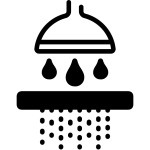Black faucets have become a popular choice in modern homes due to their sleek, stylish, and contemporary appearance. Whether matte, satin, or glossy, black faucets add a touch of elegance to any kitchen or bathroom. But with their aesthetic appeal comes a unique challenge: cleaning and maintaining their finish.
In this ultimate guide, we’ll show you how to clean black faucets effectively without damaging their surface. Whether you’re dealing with fingerprints, water spots, soap scum, or hard water stains, this blog will help you preserve the beauty of your fixtures for years.
Why Are Black Faucets Popular?
Before diving into the cleaning process, it’s helpful to understand why black faucets are in high demand:
- Modern aesthetics: Black finishes blend well with minimalistic and contemporary interior designs.
- Versatility: They pair beautifully with almost any countertop or sink material, from marble to granite.
- Durability: Most black faucets come with advanced coating technologies like electroplating or powder coating that resist corrosion and fading.
- Fingerprint and spot resistance: Some black faucets are specifically designed to hide fingerprints better than chrome or stainless steel ones.
However, while black faucets may look cleaner longer, they still require proper care to avoid dullness or staining.
Common Issues Faced with Black Faucets
While black faucets are stunning, users often face some cleaning challenges:
- Water Spots and Hard Water Deposits: Especially common in areas with hard water.
- Soap Scum: A buildup from soap, shampoo, or toothpaste.
- Fingerprints and Smudges: More visible on glossy finishes.
- Scratches: Can occur from using harsh cleaners or abrasive tools.
- Fading: Poor-quality coatings may lose color over time if not properly cared for.
That’s why knowing how to clean black faucets the right way is essential to preserve their finish and extend their lifespan.
How to Clean Black Faucets: Step-by-Step
Here’s a comprehensive, step-by-step guide on how to clean black faucets safely and effectively:
🧼 Step 1: Gather the Right Cleaning Supplies
To clean black faucets without damaging their surface, you’ll need gentle, non-abrasive tools:
Recommended Tools and Products:
- Microfiber cloth or soft sponge
- Mild liquid dish soap
- White vinegar (for hard water stains)
- Baking soda (optional for deeper cleaning)
- Spray bottle
- Soft toothbrush (for crevices)
- Filtered or distilled water (optional)
- Olive oil or baby oil (for polishing)
Avoid These:
- Abrasive pads or brushes
- Scouring powders
- Bleach or ammonia-based cleaners
- Harsh chemicals
- Vinegar directly on raw black metal
💦 Step 2: Routine Cleaning with Soap and Water
Performing light cleaning daily or weekly keeps buildup from forming.
Steps:
- Dampen a microfiber cloth with warm water.
- Add a drop of mild dish soap.
- Gently wipe the faucet, including the base and spout.
- Rinse with a clean damp cloth.
- Dry with a soft towel to prevent water spots.
This basic cleaning method is gentle enough to use regularly and helps maintain the faucet’s original shine.
⚠️ Step 3: Removing Water Spots from Black Faucets
Hard water leaves behind calcium and magnesium deposits, resulting in cloudy spots.
Method Using White Vinegar:
- Mix equal parts of white vinegar and water in a spray bottle.
- Lightly spray the mixture on the affected area.
- Let it sit for 5-10 minutes.
- Wipe with a microfiber cloth.
- Rinse with clean water and dry thoroughly.
⚠️ Warning: Do not use undiluted vinegar on matte black finishes or if your manufacturer advises against it.
🛁 Step 4: Deeper Cleaning for Soap Scum or Mineral Build-Up
If your faucet has soap scum or stubborn grime, you can use a paste made of baking soda and water:
Steps:
- Mix baking soda with water to form a paste.
- Apply the paste to the affected areas.
- Gently scrub using a soft toothbrush.
- Rinse thoroughly with warm water.
- Dry with a microfiber towel.
This method is particularly effective on bathtubs with black faucet installations, which often accumulate more soap residue.
✨ Step 5: Polishing Your Black Faucet
For that glossy showroom look, you can occasionally polish your black faucet:
Method:
- Apply a tiny amount of olive oil or baby oil to a clean microfiber cloth.
- Gently buff the faucet in circular motions.
- Wipe off any excess oil.
This not only adds a protective layer but also enhances the shine, especially for satin or glossy black finishes.
Preventative Tips: Keep Black Faucets Clean Longer
Maintaining a spotless black faucet is easier when you follow some proactive tips:
- Wipe Daily: Quickly dry the faucet after each use to prevent water spots.
- Install a Water Softener or Filter: This reduces mineral buildup from hard water.
- Use Mild Cleaners: Harsh chemicals can strip coatings over time.
- Keep a Microfiber Cloth Nearby: Make wiping part of your routine.
- Avoid Leaving Soaps or Detergents on the faucet for extended periods.
By integrating these small habits, you’ll extend the life and look of your black faucet.
How Often Should You Clean Black Faucets?
| Cleaning Task | Frequency |
|---|---|
| Light Wipe Down | Daily or After Use |
| Soap and Water Clean | Weekly |
| Hard Water Spot Removal | Monthly (or as needed) |
| Deep Clean & Polish | Monthly or Bi-monthly |
This frequency may vary based on your water type, bathroom/kitchen usage, and local environment.
Compatible Cuoll Products for Faucet Maintenance
Since Cuoll specializes in premium home improvement products like water purifiers, filters, and bathtubs, here are some great additions to consider:
- Water Filter Systems: Reduce hard water that causes staining.
- Shower Filters: Prevent mineral buildup on black bathroom fixtures.
- Bathtub Cleaning Kits: Bundle products for faucet and tub care.
- Matte Black Faucet Models: Available in corrosion-resistant finishes.
Explore our collection to upgrade your bathroom and kitchen hardware.
FAQs About Cleaning Black Faucets
Q1: Can I use vinegar on matte black faucets?
Yes, but only diluted and not too frequently. Always test a small area first and consult the faucet manufacturer’s cleaning recommendations.
Q2: What causes white spots on black faucets?
These are usually mineral deposits from hard water. Regular wiping and using distilled water or a water softener can help prevent them.
Q3: How do I prevent scratches on my black faucet?
Use only soft cloths and non-abrasive tools. Avoid any rough pads, brushes, or cleaning powders.
Q4: Is there a difference between matte and glossy black faucet care?
Yes. Glossy finishes may show more fingerprints, while matte finishes are more prone to fading if cleaned with harsh chemicals. Adjust your cleaning method accordingly.
Final Thoughts
Learning how to clean black faucets properly ensures that your elegant fixtures remain a visual highlight in your home for years to come. While these faucets are built to be durable, improper cleaning can dull their finish or cause damage over time. By using gentle cleaning methods, natural solutions, and the right tools, you can keep your black faucets looking brand new.
And don’t forget — at Cuoll, we’re committed to helping you build a better home with quality products and useful advice. Whether you’re upgrading your bathroom, installing a water filtration system, or simply need accessories, we’ve got what you need.







